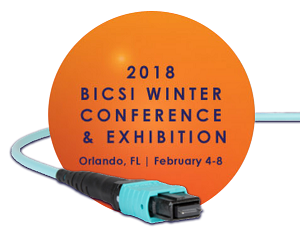Crônicas sobre cabeamento
Resumo sobre o BICSI: As 3 principais perguntas feitas
It’s always interesting at trade shows to learn what’s on the minds of end users, designers and technicians alike when it comes to testing. And this year’s BICSI Winter Conference was no different.
14 de fevereiro de 2018
Conheça a meta de perda do seu SYSTIMAX antes de falhar!
We’ve covered fiber insertion loss in plenty of past blogs, so by now we hope that you know it’s the amount of signal loss that occurs as the signal travels along a cable link. We also hope you know that insertion loss is directly related to the length of the cable—the longer the cable, the greater the loss—and that any connection point along the way (connectors, splices, splitters, etc.) also adds to the loss.
7 de fevereiro de 2018
Ganhe 3 CECs no nosso seminário pré-conferência BICSI sobre testes de conexões de fibra de alta velocidade
High speed applications are driving the deployment of multifiber MPO/MTP architectures in the data center, and it’s not just cloud and hyperscale data centers that are deploying these solutions. As the de facto interface for 40 Gig and 100 Gig switch-to-switch backbone data center applications that use parallel optics, MPO/MTP links are rapidly becoming commonplace in today’s enterprise data centers.
As the de facto interface for 40 Gig and 100 Gig switch-to-switch backbone data center applications that use parallel optics, MPO/MTP links are rapidly becoming commonplace in today’s enterprise data centers.
31 de janeiro de 2018
24 de janeiro de 2018
Será que o meu cabeamento atual suporta 2.5/5GBASE-T?
Driven by the NBASE-T Alliance and compatible with the NBASE-T specification, IEEE 802.3bz specifies 2,5 Gbps over 100 meters of Category 5e cabling or 5 Gbps over 100 meters of Category 6 cabling. It also includes support for 5 Gbps over Category 5e on defined use cases (extended frequencies).
17 de janeiro de 2018
Série 101: Polaridade MPO de 12 fibras
To properly send data over fiber cable, a link’s transmit signal (Tx) at one end of the cable must match the corresponding receiver (Rx) at the other end. And the role of polarity, which defines the direction that the signal travels, is to make sure that this correspondence is maintained. Fiber polarity is one area that seems to cause a lot of confusion in our industry – especially when it comes to multifiber MPO solutions used in parallel optic applications.
10 de janeiro de 2018
2018 - Exatamente na revolução da IoT
At this time of year, every industry tends to reflect on the past twelve months and make predictions about what 2018 will bring – it’s just what we do. So why should this year be any different?
3 de janeiro de 2018
Alguns dos nossos blogs favoritos
In the spirit of the season and that “Sound of Music” favorite by Julie Andrews (that some have dubbed a holiday classic), we thought we’d take a moment to wish everyone Happy Holidays and Best Wishes for a Prosperous New Year and share with you a recap of some of this years’ favorite Cabling Chronicles (yes, it is sung to the tune of “My Favorite Things.”)
27 de dezembro de 2017
CPR - um regulamento não tão ridículo
There’s no doubt that the European Union has a lot of rules and regulations—something frequently pointed out by those who campaigned for a Brexit vote in the United Kingdom. And many joke about some of the more ridiculous ones, like the law that prohibits people from eating pet horses, or the one that prohibits manufacturers of bottled water from labels suggesting that consumption could fight dehydration. (Since when didn’t water fight dehydration?)
20 de dezembro de 2017
Solução de problemas de emendas por fusão
A fusion splice is when two fibers are fused together using an electric arc. Often used with pigtails for connecting 250-micron outside plant fiber to 900-micron inside plant fiber at the building entrance, fusion splicing is achieved with a fusion splicing machine after the fiber is properly cleaved with a precision cleaver. Fusion splicing can be done for a single fiber or for 12-fiber ribbon cable via mass fusion splicing that splices all 12 fibers at once.
13 de dezembro de 2017




